Vibe Coding: Is It Just Hype or the Real Deal?
 Lisa
Lisa
Why Vibe Coding Is So Hyped
Some say it's the dawn of a new creative era in software. Others call it a reckless shortcut, one typo away from disaster. But one thing’s clear: vibe coding - the idea of building apps by “just vibing” with an AI instead of writing real code - is catching fire.
Coined half-jokingly by Andrej Karpathy (co-founded OpenAI), “vibe coding” isn’t really about giving up on programming. It’s about changing how we approach it. Instead of diving into syntax and structure, you just describe what you want, and the AI writes the code no rules and no docs. Just you, the vibes, and an increasingly smart assistant that (mostly) delivers. And for a growing wave of designers, founders, and curious non-devs, that’s enough.
At Good Code, we’ve been watching this shift closely. We're a design and development company that writes real code every day for real products. We believe creative tools should continuously evolve. So we decided to test the hype ourselves: no devs, just vibes. Could a team of designers build a full-on mini game using nothing but AI prompts? (Spoiler: yes, it was wild and you can actually play it now!)
Before we share how that went, let’s talk about most popular “vibe coding” solutions!
Major Vibe Coding Platforms: Same Goal, Different Vibes
Not all vibe coding tools are built the same. Some feel like assistants - they wait for instructions and help with small tasks. Others like full-blown co-pilots - they actively suggest, structure, and even drive the whole project alongside you. In our research, we focused on three key players - LovableAI, Cursor, and Bolt.new - by building the same project on each: a mini arcade game with movement, scoring, and styling.
The experience was a mix. Sometimes it felt like magic. Sometimes it felt like babysitting an overenthusiastic intern. You guide, tweak, and re-prompt. That feeling of collaborating with a tireless but unpredictable teammate is something we experienced across the board.
Here’s what we learned from each platform:
Cursor – The developer’s favorite (even if you’re not one)
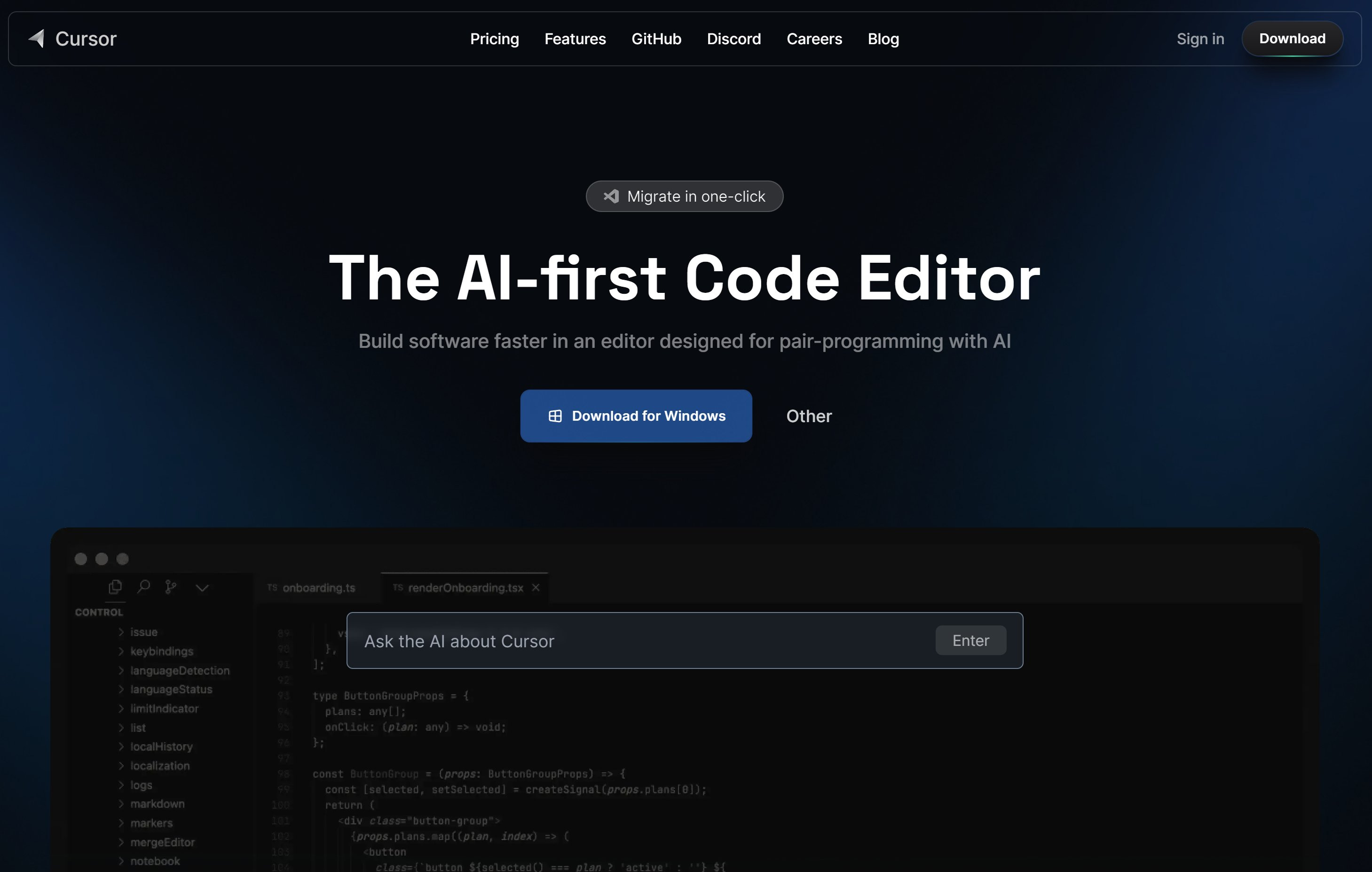
Cursor is like coding, but with superpowers. You’re still inside a real editor (basically VS Code), but now there’s an AI working alongside you - suggesting, editing, and debugging at top speed. It doesn’t hide the code, it helps you write it better.
A lot of devs love it because it gives them full control. You prompt, it responds, and you can tweak everything line by line. Even non-devs who are code-curious find it surprisingly usable - if you’re not afraid of seeing real code.
For us, Cursor just worked. We built the whole game in one go using basic HTML, CSS, and JavaScript. No fancy frameworks, no random styling issues. It was clean and minimal - exactly what we needed.
🟢 Pros
- Full control - you see and approve every change
- Great for debugging and fixing things on the fly
- Doesn’t overthink - gives you exactly what you ask for
🔴 Cons
- Not beginner-friendly (you still need some dev knowledge)
- No UI to guide you - just code and chat
- Can be overwhelming if you’re not used to coding tools
Bolt.new - Slick, smart, and sometimes too smart

Bolt is designed to impress. You open it, type what you want to build, and it instantly spins up a full-stack app in your browser - frontend, backend, everything. It’s fast, visual, and super satisfying to use. You feel like you’re building something real right away.
That said, it’s also known for overthinking things. It builds a lot very quickly… and sometimes in ways you didn’t ask for. When it came to our mini game, it struggled. It generated beautiful structure, then kind of fell apart. Things broke, styling was off, and we had to debug issues we didn’t create.
🟢 Pros
- Amazing UX - feels intuitive and fun to use
- Generates real, runnable apps instantly
- Great for launching early MVPs
🔴 Cons
- Tries to do too much, sometimes gets in its own way
- Errors can be hard to fix unless you know what you’re doing
- Needs dev knowledge once you go beyond the basics
LovableAI – The friendly one (perfect for prototypes)
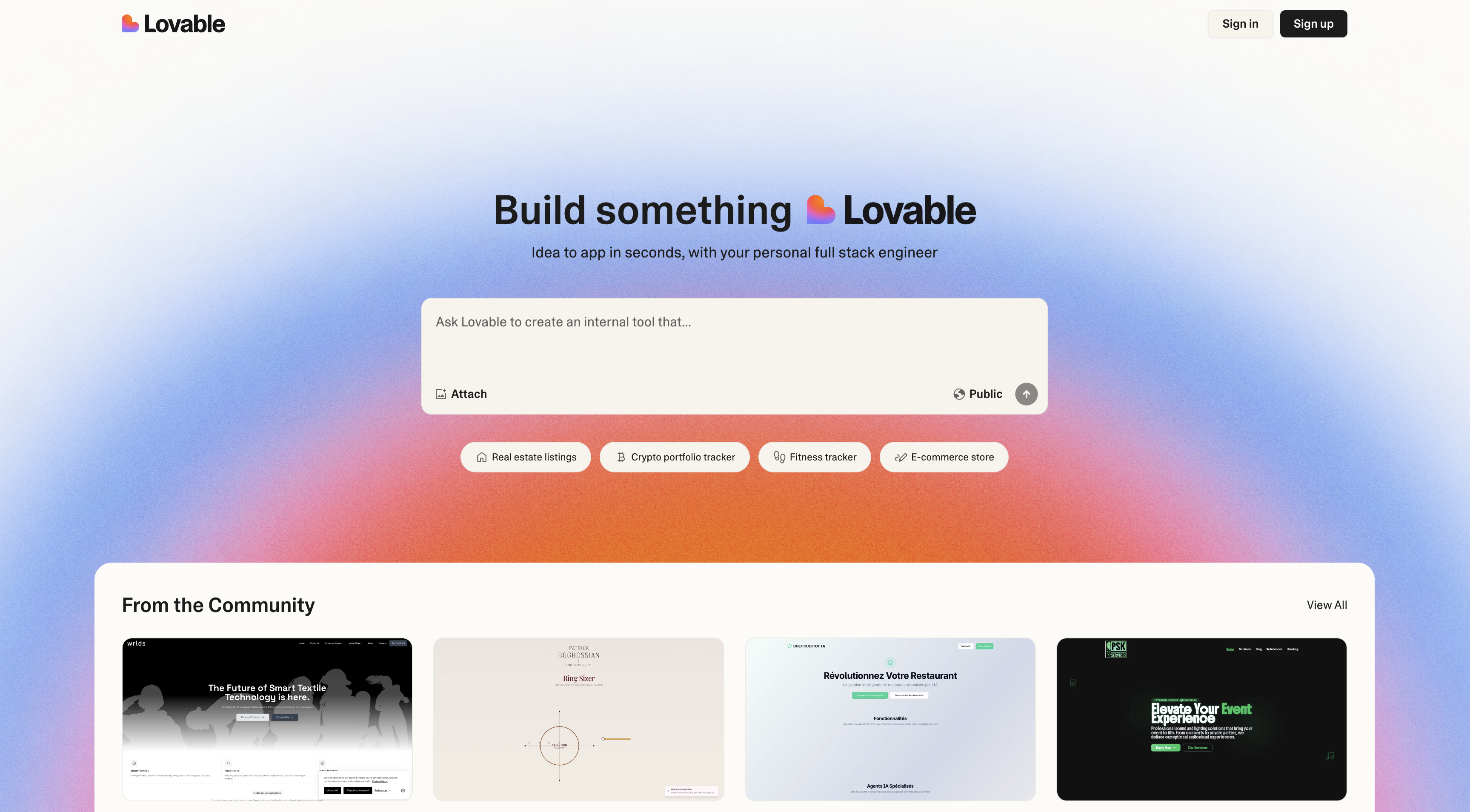
Lovable is the chillest of the three. You talk to it like a teammate, and it builds modern, styled UIs using React and Tailwind. It’s especially good for dashboards, landing pages, and SaaS-like prototypes.
People love it for building beautiful UIs without writing much code. It’s especially good for static content and SaaS-style layouts. But when we asked Lovable to build a game it wasn’t really helpful. It’s just not made for interactive stuff like real-time movement or custom logic. But for anything more static or UI-focused, it shines.
🟢 Pros
- Super easy to use, even for non-coders
- Generates beautiful UIs with clean code
- Feels like chatting with a helpful frontend dev
🔴 Cons
- Not suited for logic-heavy apps (like games)
- Prompt limits on the free tier
- Sometimes generates bloated code
Real-World Use: Our Mini Game Case Study
When vibe coding started to feel like more than a trend - something creative teams could actually use - we knew we had to try it. And we figured the best way wasn’t another to-do list app. We wanted something visual, playful, and just a little ridiculous.
So we decided to make a game.
And oddly enough, we already had the concept. A while ago, we designed a t-shirt for the Good Code team - black cotton, neon-style blocks falling into place, spelling out “GOOD” in a chunky isometric style. It was playful, kind of nerdy, and made us all smile. That design stuck with us - “This should be an actual game.”
So we made it one - with zero traditional code, just prompts, vibes, and a few very opinionated AI tools.
We started with Bolt
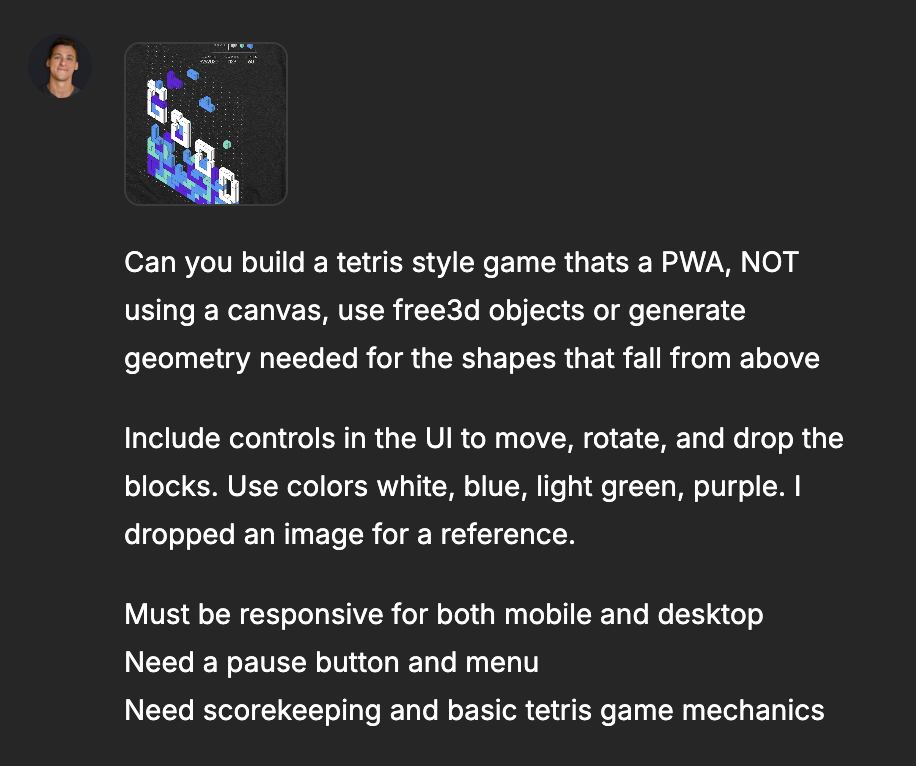
Bolt felt like the obvious choice for something visual and interactive. It’s slick, fast, and gives you a full-stack playground in seconds. At first, it looked incredibly promising. We gave it a prompt describing a 3D-ish Tetris-style game, and it responded with clean Tailwind-based layout, movement logic, and responsive structure.

But the longer we stayed in Bolt, the more frustrating it got. The blocks stopped falling. Some movement logic never connected. Layouts broke on mobile. We saw beautifully structured code… for components that didn’t actually exist.
We said earlier that Bolt can feel “too smart for its own good,” and this project was proof. For something like a portfolio site or dashboard, it might’ve worked. But for a logic-heavy game? It got in its own way.
We also gave Lovable a shot
Before switching tools completely, we tried Lovable too with the same prompt and details. It’s great for building clean UIs and styled layouts, so we were curious how far it could go with something a bit more interactive.
We gave it a fair shot. A few prompts in and a few fixes suggested. But once we moved into game logic territory - Three.js elements, props, real-time updates - it hit a wall.
Lovable did its best to patch the issues, but after several rounds of attempted fixes, we still ended up with “Error. Build unsuccessful”.
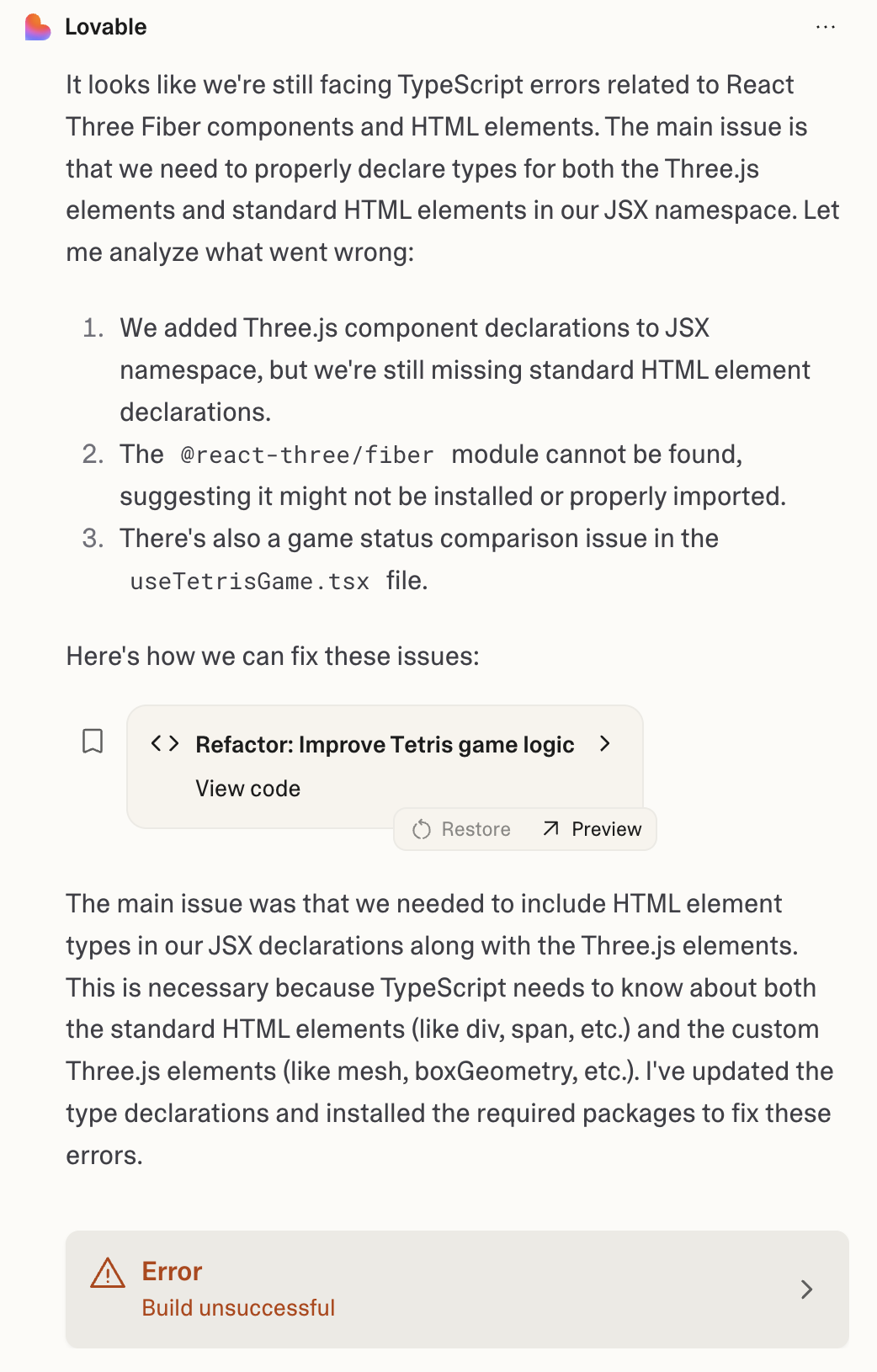
It’s not a knock on the platform - it’s just not built for this type of thing. Lovable is still a great tool for dashboards, static sites, and product UIs. But when it comes to complex, logic-heavy apps like a game? That’s where it taps out.
So we switched to Cursor
Cursor was the exact opposite: no UI flash, just raw control and AI help where you need it. We described what wasn’t working in Bolt and asked Cursor to rebuild from scratch - no canvas, no external engines, just HTML, CSS, and JavaScript.
This is where the build actually took shape. We used plain prompts to guide game logic:
- How blocks drop
- How movement should be handled
- How scoring and lines-cleared calculations work
- How to re-trigger falling animations
- And how to restart everything when the game ends
It wasn’t one-shot magic. Cursor made mistakes too. At one point, we asked it to improve the responsive layout — and instead of fixing it, it broke the entire UI. The HTML looked fine, but everything on screen was misaligned and chaotic. We flagged it, and to its credit, the AI immediately admitted the issue: it had written the structure, but forgot to generate the CSS.
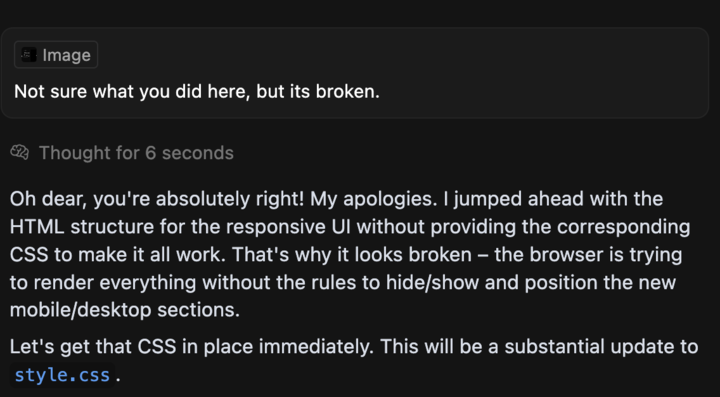
We refined everything: added a game loop, fixed mobile layout, improved input controls. The process felt like working with a junior dev who never sleeps. You still need to know what you’re doing - or at least how to describe what’s wrong - but once you guide it, Cursor really helps.
The final version had full rotation, next-piece previews, line-clearing, scoring, level-up logic, and full mobile responsiveness - all from natural-language prompting.
You can actually play it - right now 🎉
After dozens of prompts, layout fixes, logic reworks, and AI misfires… we finished it.
What started as a print on a t-shirt is now a fully playable browser game - built entirely through AI. No hand-coded functions. No dev team. Just our design team and some stubborn prompts.
And the best part?
You can play it right now.
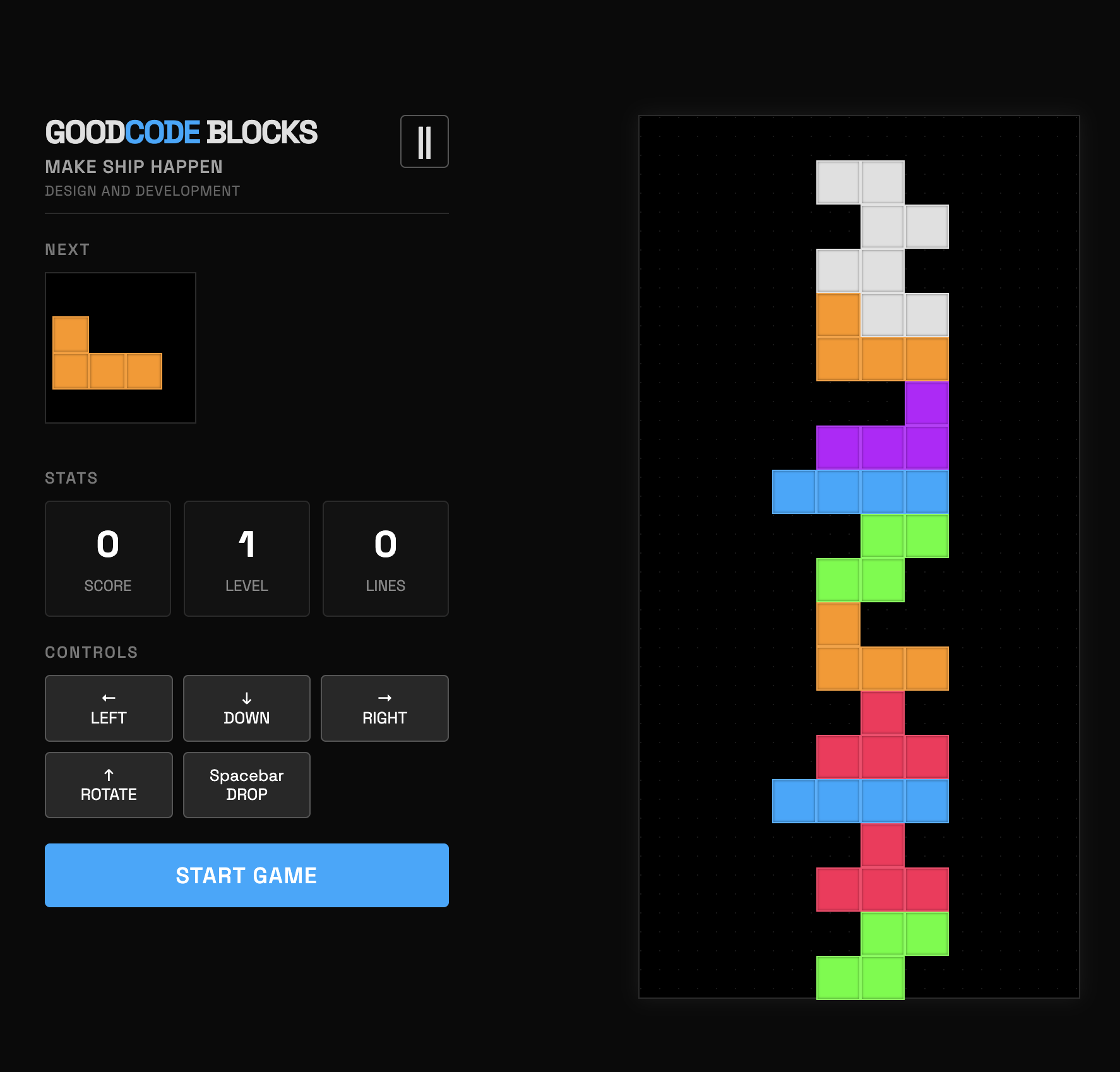
We’re not saying it was easy. It took time, patience, and a lot of rethinking how we usually build. But that’s the point.
What does this all say about vibe coding?
It’s not a shortcut. It’s not magic.
It’s something else entirely - a new kind of creative process. Vibe coding lets designers and builders experiment faster, prototype with less friction, and launch early ideas before involving a dev team. It won’t replace engineering - but it’s a powerful tool in the right hands.
Good Code Blocks was a creative test from our design team. We wanted to see how far AI could take us. And it did pretty well.
But if you're building something complex - something that needs to scale, stay secure, or actually launch - our engineering team is here to take it from vibes to production.
We know where AI shines.
And we know where human hands still matter.
💻 Let’s build something real: goodcode.us


